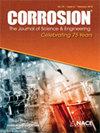Crevice Corrosion of High-Grade Stainless Steels in Seawater: A Comparison Between Temperate and Tropical Locations
IF 1.1
4区 材料科学
Q4 MATERIALS SCIENCE, MULTIDISCIPLINARY
引用次数: 0
Abstract
The corrosion risk for stainless steel components is not the same in all seawaters, with more failures generally reported in tropical seas. In this study, the influence of biofilm on electrochemical behavior and corrosion resistance of passive films of high-grade alloys was studied in different seawaters, including temperate seawater (France-Brest, North Atlantic Ocean), tropical seawater (Malaysia-Kelatan, Meridional China Sea), and intermediate conditions in terms of temperature (Brazil-Arraial do Cabo, South Atlantic Ocean). The stabilized open-circuit potentials and the polarization behavior of high-grade stainless steels were measured as function of temperature in all the tested field marine stations, providing quantified data and direct comparison on the biofilm-enhanced corrosion risks. Significant differences were measured in tropical and in temperate seawaters in heated conditions above 30°C. In parallel to the monitoring of biofilm-induced depolarization, crevice corrosion of 8 high grades passive alloys was studied with the use of crevice formers specifically developed for tube geometries. Duplex, super-duplex, hyper-duplex and 6Mo stainless steels tubes have been evaluated together with Ni-based alloys. The corrosion results are discussed regarding the monitored biofilm-induced depolarization measured in the different test conditions.高档不锈钢在海水中的缝隙腐蚀:温带和热带地区的比较
不锈钢部件在所有海水中的腐蚀风险并不相同,热带海域通常报告的故障较多。在本研究中,研究了生物膜对高档合金钝化膜电化学行为和耐蚀性的影响,包括温带海水(法国-布列斯特,北大西洋),热带海水(马来西亚-克拉丹,中国经向海域),以及温度方面的中间条件(巴西- arraial do Cabo,南大西洋)。在所有测试的现场海洋站中,测量了稳定开路电位和高级不锈钢的极化行为作为温度的函数,为生物膜增强腐蚀风险提供了量化数据和直接比较。在30°C以上的加热条件下,在热带和温带海水中测量到显著差异。在监测生物膜引起的去极化的同时,研究人员还利用专门为管道几何形状开发的裂缝形成器研究了8种高等级被动合金的裂缝腐蚀。双相、超双相、超双相和6Mo不锈钢管与镍基合金一起进行了评价。讨论了在不同试验条件下监测的生物膜诱导去极化腐蚀结果。
本文章由计算机程序翻译,如有差异,请以英文原文为准。
求助全文
约1分钟内获得全文
求助全文
来源期刊

Corrosion
MATERIALS SCIENCE, MULTIDISCIPLINARY-METALLURGY & METALLURGICAL ENGINEERING
CiteScore
2.80
自引率
12.50%
发文量
97
审稿时长
3 months
期刊介绍:
CORROSION is the premier research journal featuring peer-reviewed technical articles from the world’s top researchers and provides a permanent record of progress in the science and technology of corrosion prevention and control. The scope of the journal includes the latest developments in areas of corrosion metallurgy, mechanisms, predictors, cracking (sulfide stress, stress corrosion, hydrogen-induced), passivation, and CO2 corrosion.
70+ years and over 7,100 peer-reviewed articles with advances in corrosion science and engineering have been published in CORROSION. The journal publishes seven article types – original articles, invited critical reviews, technical notes, corrosion communications fast-tracked for rapid publication, special research topic issues, research letters of yearly annual conference student poster sessions, and scientific investigations of field corrosion processes. CORROSION, the Journal of Science and Engineering, serves as an important communication platform for academics, researchers, technical libraries, and universities.
Articles considered for CORROSION should have significant permanent value and should accomplish at least one of the following objectives:
• Contribute awareness of corrosion phenomena,
• Advance understanding of fundamental process, and/or
• Further the knowledge of techniques and practices used to reduce corrosion.
 求助内容:
求助内容: 应助结果提醒方式:
应助结果提醒方式:


